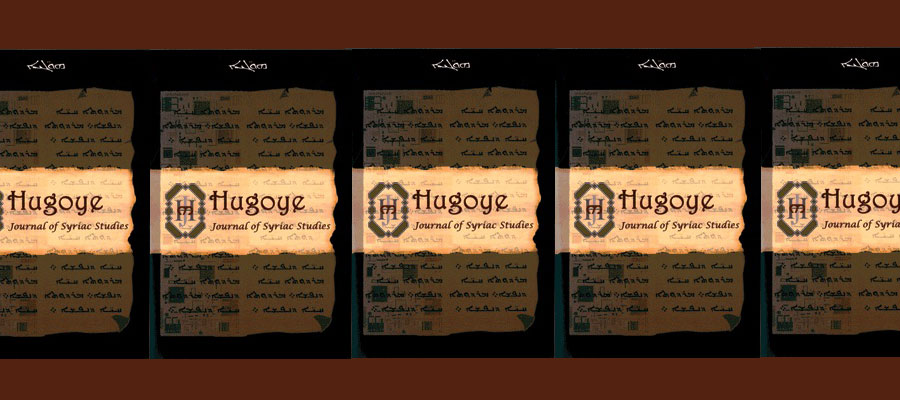Hugoye: Journal of Syriac Studies, volume 25, no. 1 (2022).
CONTENTS INCLUDE
Vast Lessons: Jacob of Edessa’s The Six Days and the Tools of Knowledge
Ellen Muehlberger
Jacob of Edessa’s early eighth-century work The Six Days bursts with information about the cosmos and its inhabitants, the earth’s geography, its species, and other details of nature. Scholars have long classified it in the genre of hexameral literature; in the first part of this essay I explore the limits of that identification. In the second part of the essay, I consider another ancient genre by which The Six Days might be described—compendiary literature—but demonstrate that the features of the text do not square with the generic conventions scholars have identified as central to that literature. The Six Days thus bears a lesson for us: it cautions us to rethink our systems of classification for ancient literature.
Stages of the Harklean Tradition and the Process of Its “Byzantinization” in the Example of the Gospel of Luke in the MS Chaldean 25 of Alqosh
Piotr Jutkiewicz
Andreas Juckel has shown that MS Vat. Sir. 268 is the best witness to the Harklean text of the Gospels, since its text is less “byzantinized” than the other manuscripts. However, the complexity of the particular features of the Harklean version (variant readings in the margin and “critical signs” in the text) and their transmission history elude easy and conclusive solutions. This paper illustrates that the process of “Byzantinization” of the Harklean text was not a unilateral development, but rather a complex and multidimensional transformation that still needs more research, as even late Harklean manuscripts may preserve ancient and original readings. MS Chaldean 25 of Alqosh, which lays at the dawn of the new revision of the Harklean version by Dionysios bar Salibi in the twelfth century, is helpful in tracing the process of these textual transformations.
The Memra of Patriarch Mar ’Īšō‘yahb I of Arzōn (581-595): The Cause of the ‘Holy God’
Mar Awa III
In 1917, Guiseppe Furlani introduced the Syriac world to an otherwise unknown sixth century document composed by Mar ’Īšō‘yahb I the Arzōnite, catholicos-patriarch of the Assyrian Church of the East from 581 to 595. Furlani provided the Syriac text of the memrā of ’Īšō‘yahb I, which was an apology for the liturgical and theological use of the Trisagion by the Church of the East. It was accompanied by a study of the text and the sole manuscript which contains it. The importance of this document is manifold. First, it is not mentioned by Mar ‘Abdīšō‘ of Nisibis in his famous ‘Catalogue’, and therefore seems to be an anomaly. Second, this memrā gives us the terminus ante quem for the insertion of the Trisagion in the rite of the Church of the East in the greater framework of the development of this rite. Third, and of great import, the memrā provides a springboard for the author to express and defend the christological position of the School of Nisibis, his alma mater and the center of Church of the East orthodoxy in the mid-sixth century. The English translation of this important memrā is offered here for the first time, along with a study of the historical and theological contexts of the tractate at the time of its composition sometime in the latter half of the sixth century.
Early Witnesses to the Syriac Text of Acts 15 with an Investigation into the Text of Acts 15 in the Didascalia Apostolorum: And with an Appendix on the Western / Jacobite Peshitta Manuscript Tradition for Acts
Daniel L. McConaughy
This paper examines the transmission of the early Syriac text of Acts Chapter fifteen based on collations of 44 Syriac Biblical manuscripts and 6 lectionary manuscripts and citations of Acts in the Syriac patristic sources. Chapter fifteen is extensively quoted in the Didascalia Apostolorum, and these readings are the focus of the analysis of the patristic sources. The collation results show a very consistent text among the Biblical and lectionary manuscripts. The collations also support the idea that the Peshitta text of Acts appears less revised than the Gospel text in the Peshitta version. This is most evidenced by the many ‘Western’ text readings present in the Peshitta, the lack of variant readings of any significance in the mss, and the use of the Peshitta in the fourth century Syriac translation of the Didascalia. The appendix to this article provides an analysis of the Western / Jacobite manuscript tradition for Acts.
